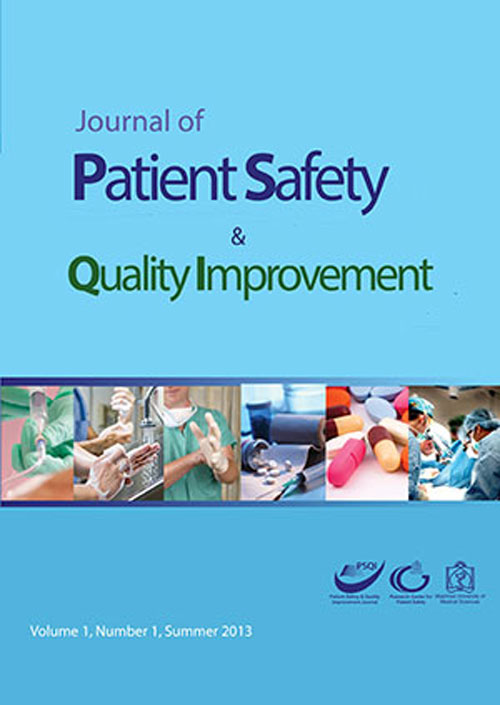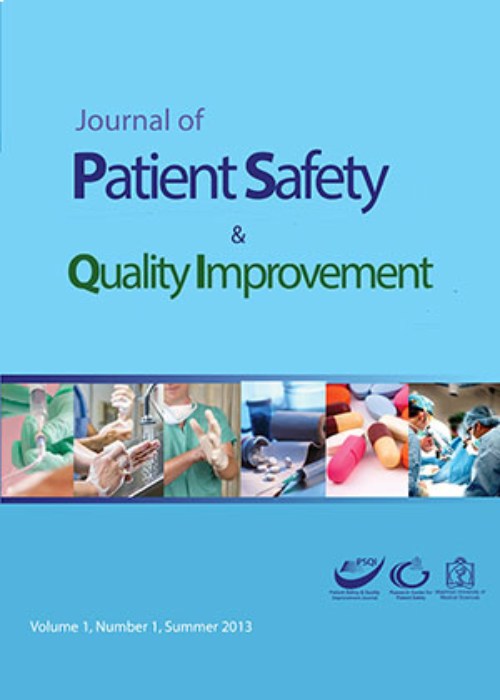فهرست مطالب

Journal Of Patient safety and quality improvement
Volume:3 Issue: 1, Winter 2015
- تاریخ انتشار: 1393/11/11
- تعداد عناوین: 8
-
Pages 175-178IntroductionMalnutrition is a general problem in hospitalized patients. Enteral feeding in Intensive Care Unit (ICU) has been stated to decrease the metabolic response to stress, decline bacterial translocation, and preserve gut mucosal integrity. To assess the efficacy and complications of Nutrika supplement for enteral feeding in Intensive Care unit.Materials And MethodsNutrika is an enteral nutritional supplement. 12 patients (six male, six female) who received Nutrika supplement through Nasogastric Tube (NGT) in ICU department of Ghaem Hospital were studied. Evaluating gastrointestinal tolerance, biochemical tests, daily calorie intake and the measurement of arm circumference were done daily. Mean admission duration of these hospitalized patients was ten days and it should be noted that the average amount of received gavage was 200 ml/2h.Resultsfour patients (two male, two female) had diarrhea when they received this supplement in consecutive meals. Two patients (female) experienced abdominal pain after consuming this supplement; however the prevalence of all gastrointestinal intolerance symptoms among patients were not statistically significant (P=0.25, P=0.50, P=0.50). Albumin and Urea level alter significantly during supplementation (P=0.001, P=0.002). Rest of the laboratory values did not change significantly. In two patients (one male, one female) who were completely intolerant to this solution, arm circumference had two cm decrease.ConclusionAlthough this supplement has some complication including distension and diarrhea, however it is strongly suggested to use due to severe malnutrition in ICU ward and plays a significant role in improving general condition of these patients.Keywords: Nutrika supplement Intensive care unit Enteral nutrition
-
Pages 179-183IntroductionPatient satisfaction is an accurate assessment factor for evaluating the performance of health policies in the community. The purpose of this study is to assess patients'' satisfaction with emergency department of Imam Reza hospital of Mashhad Iran.Materials And MethodsIn this cross-sectional study, during six months period from April to October 2012, 420 patients were entered to study in morning, evening and night shifts before being discharged or transferred from emergency department. The Press Ganey questionnaire of patient satisfaction was completed.Results420[daneshgar1] patients in three work shifts of morning (140 patients) evening (140 patients) and night (140 patients) participated in our research. 226 (53.8%) of participants were male and 194(46.2%) were female. The average of patients’ time waiting for doctors'' visit was 10.7±6.1 minutes. The mean score of satisfaction during attendance in Emergency Department (ED), during physicians'' visit and overall satisfaction was 25.24±5.04, 25.32±5.42, 8.52±1.91 respectively. The highest level of satisfaction is related to speed of admission (81%), medical treatment (76%), nursing skills for doing medical orders (71.4%) and lowest level of satisfaction is related to comfort and pleasantness of the waiting area (45.9%), time the physician spent with the patient (56.5%) and length of wait before going to an exam room (62.8%).ConclusionAttempt for reducing waiting time, providing comfort environment, increasing the time of visit with emergency physicians and enhance service quality based on patient needs can reduce the patient dissatisfaction.Keywords: Emergency department Patient satisfaction Physicians
-
Pages 184-187IntroductionThe aim of this study was to compare Alfentanil with Remifentanil regarding postoperative nausea and vomiting.Materials And MethodsIn this double-blind randomized controlled trial, we studied 60 patients, between 17-48 years old with American Society of Anesthesiologists class I or II undergoing septorhinoplasty. The patients signed informed consent and then were randomly divided into two groups. Induction was started similarly in both groups using Midazolam, Propofol and Atracurium whereas group one Alfentanil group (AL group) received Alfentanil and group two Remifentanil group (R group) received Remifentanil. We used Alfentanil with Propofol in the AL group or Remifentanil with Propofol in the R group as maintenance drugs. We assessed nausea and vomiting with Visual Analogue Scale (VAS) from the extubation time until 24 hours after the surgery. We used ondansetrone to relieve nausea.ResultsOur patients had a mean age of 25.7±5.4. 75% were female and 25% were male. Duration of surgery had a mean time of 167.5±15.8 minutes and there was not statistically any difference between the two groups. We assessed nausea and vomiting incidence and severity on Visual Analogue Scale score in 0-1 hour, 1-6 hours and 6-24 hours after surgery. The highest nausea and vomiting incidence was in 1-6 hours after the surgery and the two groups were statistically the same.ConclusionOur results did not show a statistically significant difference between using Alfentanil and Remifentanil as induction and maintenance drugs, regarding nausea and vomiting in the 24 hours post operation period.Keywords: Postoperative nausea, vomiting Alfentanil Remifentanil Septorhinoplasty
-
Pages 188-192IntroductionEvidence-Based Medicine (EBM) means ensuring that the right patient has received the appropriate treatment and it strives to form a common scientific language for all doctors. It uses the combination of the best available knowledge (evidence) and clinical experience beside the patient values. This study was designed to investigate the attitude of medical residents of Mashhad University of Medical Sciences towards EBM.Materials And MethodsIn this cross sectional study a self-designed questionnaire was used for data collection. The study was performed in the autumn of 2012 in Mashhad University of Medical Sciences, Mashhad, Iran. The study aimed at investigating the attitude of medical residents towards EBM and evaluating its use in medical practice. Questionnaires’ data were analyzed by the SPSS Version 13.Results49 (52.1%) residents were familiar with the concept of EBM whereas 45 (47.9%) were not. The rate of familiarity with EBM concepts was (26.5%) in the surgical fields and (73.5%) in the non-surgical ones, showing a meaningful difference (p=0.014). There was a significant correlation between the field of study and knowledge about the concepts of EBM, whereas a greater number of non surgical residents were familiar with its concept in comparison to surgical residents (73.5% vs. 26.5%, p=0.014).ConclusionThe concepts of EBM are familiar to (82%) of medical residents of Mashhad and regarding the increasing importance of this science, upgrading EBM concepts in a timely and accurate planning is highly recommended.Keywords: Evidence Based Medicine Resident Mashhad
-
Pages 193-195IntroductionRetinal vein occlusion is one of the most common forms of vascular disease in retina, and leads to visual loss in patients. Various treatment options were proposed for this disorder. The aim of this study was to compare axial length in eye with retinal vein occlusion in comparison with intact eye.Materials And MethodsAfter ethical approval, this case-control study was designed in Mashhad University of medical sciences. We selected 63 patients with retinal vein occlusion and 23 control group. Axial length was measured by a mode scan (NIDEK-US 4000, Japan), macular thickness (macular edema) was evaluated by Optical Coherence Tomography (ZEISS, Germany). Data were analyzed with SPSS Version 16. P<0.05 was considered as significant level.ResultsAxial Length (AL) in eye with central retinal vein occlusion was significantly shorter in comparison with control group (P=0/003). AL was not differed significantly in affected eye in patients with Central Retinal Vein Occlusion (CRVO) and Branch Retinal Vein Occlusion (BRVO) (P=0.8). There was not a significant difference between AL in intact eye of patients with CRVO (P=092) and BRVO (P=0.54) in comparison with control group.ConclusionAxial length in patients with central retinal vein occlusion was shorter than AL in BRVO and control group.Keywords: Central retinal vein occlusion Branch retinal vein occlusion Axial length
-
Pages 196-197IntroductionTo evaluate the surgical causes in pulmonary infection in children.Materials And MethodsIn this cross sectional study 203 patients aged between one month and 12 years old were studied in pediatric wards at Ghaem hospital in Mashhad, Iran.ResultsMost of patients were male and younger than one year old. Fever and cough were among the most common presentations. Foreign body aspiration, hydatid cyst, empyema and lung abscess were the most common causes that required surgical intervention.ConclusionForeign body aspiration and hydatid cyst, empyema and lung abscess are the most common causes of surgical intervention in children with pneumonia.Keywords: Lower respiratory tract infection Surgery Children Empyema
-
Pages 198-200Diffuse Large B-Cell Lymphoma (DLBCL) is the most common type of Non-Hodgkin Lymphoma (NHL) which includes about (25%) of the cases. Patients with DLBCL have a rapidly growing mass that is located in the neck or abdominal region. Multiple Myeloma Oncogene (MUM1) has an important role in lymphoid cell differentiation. MUM1/IRF4 is as oncogene related to myeloma and translocation (p25; q32), t (6; 14) and leads to a change in the heavy chain of Immunoglobulin (IGH). BCL6 exists in approximately (100%) of follicular cell cancer cases, (100%) of Burkitt lymphoma, (80%) of large B-cell lymphoma, and in more than (80%) of nodular lymphocytic Hodgkin lymphoma cases. BCL6 is related to cancers with a high proliferation cell index. In some studies BCL6 is expressed as a prognostic factor in LBCL patientsKeywords: Diffuse large B, cell lymphoma MUM1 BCL6
-
Pages 201-202IntroductionPresenting a case with repeated episodes of flat Anterior Chamber (AC) after Ahmed valve implantation, and suggesting a simple suturing procedure to manage these recurrences. Case:A 65-year-old woman presented to our clinic with uncontrolled Neovascular Glaucoma (NVG) in her left eye due to advanced Proliferative Diabetic Retinopathy (PDR) despite full medication to reduce Intraocular Pressure (IOP). After Ahmed valve implantation, anterior chamber became flattened spontaneously on postoperative day one. Therefore, we filled the AC with air at the first attempt but this procedure failed a day later. Then, we filled the AC with an ocular viscoelastic device. Because of these procedures failed to keep the AC formed, we hypothesized that it may be a malfunctioned valve. Therefore, we inserted 5-0 Nylon in Ahmed tube through AC and fixed it to the subconjunctiva two days after the second procedure. Anterior chamber remained deep and its shallowing did not occur despite removing the suture two weeks after the insertion. The IOP was controlled well with a functional filtering device at the last follow–up visit four months after the surgery.ConclusionSpontaneous episodes of flat AC after Ahmed valve implantation in an eye can be well managed by inserting a removable suture into the Ahmed valve tube.Keywords: Ahmed glaucoma valve Flat anterior chamber Hypotony 5.0 nylon suture


